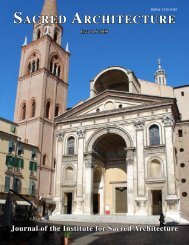Download Issue PDF - The Institute for Sacred Architecture
Download Issue PDF - The Institute for Sacred Architecture
Download Issue PDF - The Institute for Sacred Architecture
- No tags were found...
You also want an ePaper? Increase the reach of your titles
YUMPU automatically turns print PDFs into web optimized ePapers that Google loves.
SPANISH COLONIAL SACRED ARCHITECTURETHE NEW PARISH CHURCH OF SAN JUAN CAPISTRANOA R T I C L E SJust why it took a century and a half andmore to replace an historic parish churchdestroyed by earthquake in 1812 is too involveda story to tell here, and not very relevantto ecclesiastical architecture. Lincolnbuffs, of course, will want to know thatAbraham Lincoln played a role in it by givingthe ruins back to the Catholic authorities.What interests us most here is an exampleof architecture as a pastoral instrument.<strong>The</strong> San Juan Capistrano Regional Library,by the Postmodernist masterMichael Graves, sits on a knoll at the cornerof El Camino Real and AcjachemaStreet, occupying a curiously rural slice ofdowntown San Juan Capistrano. A quasimanneristinterpretation of Spanish Colonialarchitecture in early Postmodernidiom, it is striking <strong>for</strong> its diminutive scale,an overgrown architectural model in woodand pastel-painted stucco. It proudly displaysthe ubiquitous pseudo-classical elementsof 1970’s and early 1980’sPostmodern: squat, purely cylindrical columns;bare lintels; paper-thin barrel vaulting;and the mandatory Aldo Rossi-inspiredfenestration.Above Graves’ liberating interpretivearchitecture, across Acjachema Street andtoward the Camino Capistrano to the west,looms the massive figure of the new parishchurch of San Juan Capistrano. Datingfrom 1986, it is an opus of the architect JohnBartlett, then based in Arcadia, Cali<strong>for</strong>nia.Built to replace the original mission parishchurch that was destroyed by earthquakein 1812, this faithfully Spanish Colonialchurch actually isn’t massive at all.<strong>The</strong> scale is in fact trompe-l’oeil. Just asGraves’s library disperses its mass bybranching out across its site, creating the illusionof smallness, the new parish churchconcentrates its own mass in a simpleunion of three separately articulated <strong>for</strong>ms:the great cupola, a bell tower, and a centralnave and transepts. It is a Classical piece,an eloquent opus sacrum, one among agrowing number of works that presage therebirth of Classicism, in all its manifestationsof <strong>for</strong>m and style, in the architectureof the Roman Catholic Church.We can only imagine the fuss thatwould have been raised had this fourteenyear-oldwork received more attentionfrom the art and architectural press at thetime of its dedication. In the case ofMichael Graves, imagination need play norole: his work, considered “too traditional,”has already been marginalized byPatrick James Riley<strong>The</strong> regional library and parish church of San Juan Capistranothe governing elites of architectural criticism.Mr. Graves is now the only remainingpractitioner of note of a once-popular architecturalmovement, the sole survivor ofthe Postmodern shipwreck.<strong>The</strong> spirit of Torquemada is alive andwell in the world of architectural criticism.Books already are being burned, and altarsdefaced and overturned. What treatmentwill be reserved <strong>for</strong> the architects and builtwork of a true Classical revival in ecclesiasticalarchitecture, especially as this movementgathers more disciples? We know theanswer to that question. But the <strong>for</strong>ces thatdestroyed the Postmodern movement willlikely be in <strong>for</strong> a surprise when they stagetheir inevitable assault on this authenticand most durable architecture.Spanish Colonial <strong>Architecture</strong> inAmericaCali<strong>for</strong>nia is peppered with buildings inthe Spanish Colonial style. From suburbanhomes to gasoline stations to major publicoeuvres, these edifices define the physicaland cultural landscape. Spanish Colonial isoften required by local design reviewboards and planning authorities as conditiosine qua non <strong>for</strong> obtaining a building permit.<strong>The</strong> “Mission style,” as Spanish Colonialarchitecture is most often called, hasbecome Cali<strong>for</strong>nia’s official architecture.Like so much of Cali<strong>for</strong>nia’s cultural produce,it has also come to symbolize, by un<strong>for</strong>tunateassociation with the recent cropof substandard design and construction, allthat is cheap, superficial, and speculativein the world of buildings.<strong>The</strong> “Mission style,” of course, wasn’tcheap or Hollywoodish in its original incarnation,the architecture of Spain’sAmerican colonies and, soon thereafter, ofthe missions founded by Blessed JuniperoSerra up the Cali<strong>for</strong>nia coast. Like most ofthe Spanish-inspired architecture of theNew World, the “Mission style” derivesfrom Spanish Plateresque and Churrigueresquearchitecture.Late fifteenth-century Plateresque freelyborrowed the decorative motifs of the intricatelydetailed work of Spanish silversmiths,the “Plateros.” In the seventeethcentury, after the restrained Juan deHerrera interlude, decorated architecturein Spain reached an apotheosis in the exuberant—somewould say capricious—Churrigueresque baroque, named after theChurriguera, a family chiefly known in itsday <strong>for</strong> the design of altars. Characteristicof both the Plateresque and Churrigueresqueare the elaborate frontispieces thatare then applied to an otherwise flat facade.<strong>The</strong> architectural elements in thesedecorations, columns, entablatures, pedimentset al play a purely decorative role.With the Plateresque andChurriguerresque, Spain’s Gothic moment,based like all Gothic on structural purism,meets its end.<strong>The</strong> Spaniards eventually exported theirdecorated architecture to Southern Italyand to their colonies in the Americas. In the18 th century the Churrigueresque set rootsin Mexico, while a native brand of Plateresque,the Mexican Plateresque, less exactin the carving of ornamental details than itsSpanish <strong>for</strong>ebear, emerged. This architecturewould come to define Spanish Colo-Photo: Church of San Juan Capistrano<strong>Sacred</strong><strong>Architecture</strong> Fall 2000 19










